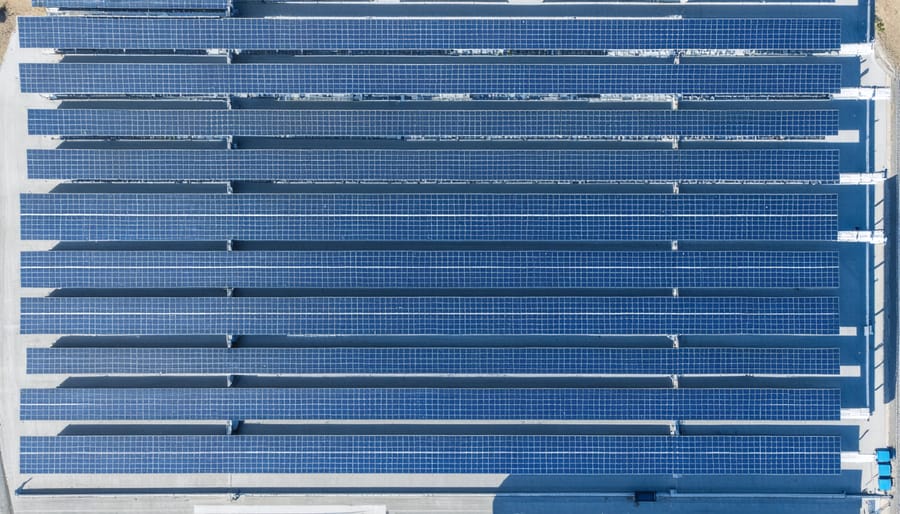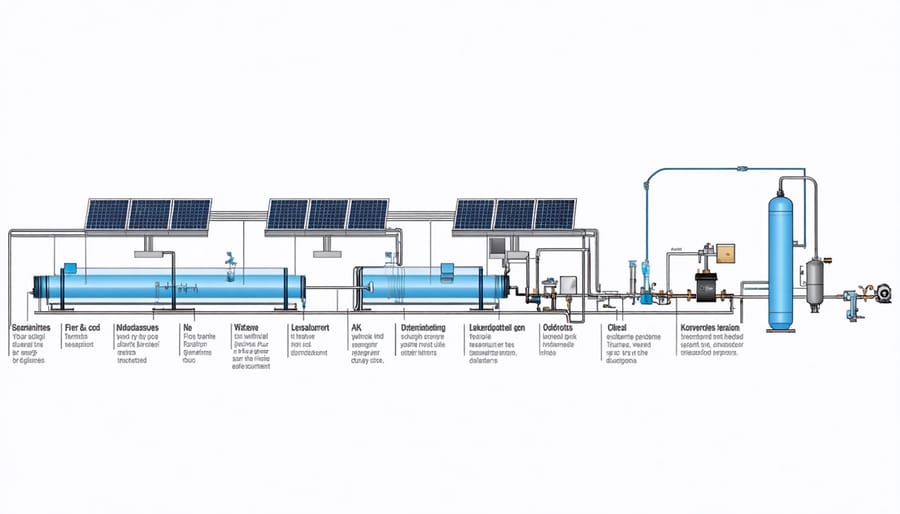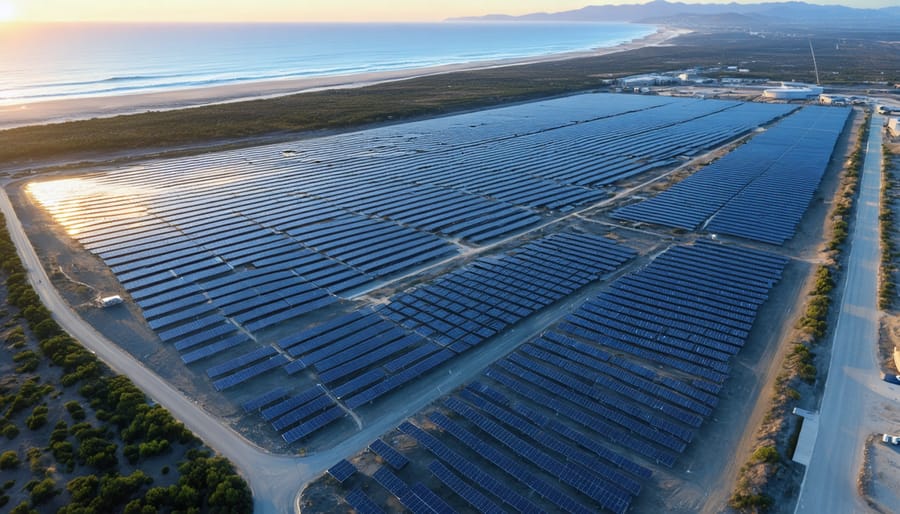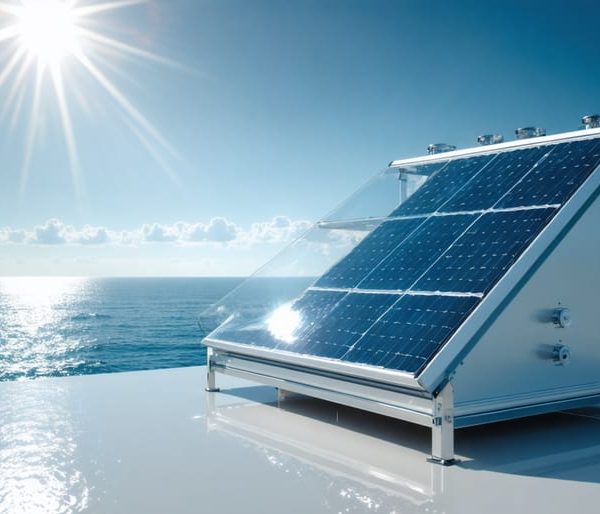Solar-Powered Desalination Plants Are Transforming U.S. Water Security
As America faces increasing water scarcity challenges, desalination plants have emerged as a crucial solution for securing our nation’s water future. From California’s massive Carlsbad facility to Texas’s innovative Kay Bailey Hutchison plant, these technological marvels are transforming seawater into fresh drinking water for millions of Americans. Modern solar-powered desalination technology is revolutionizing this process, making it more sustainable and cost-effective than ever before.
With over 2,000 desalination facilities operating across the United States, these plants represent a growing commitment to water security and environmental stewardship. As climate change intensifies drought conditions in many regions, desalination offers a reliable, drought-proof water source that’s becoming increasingly vital for coastal communities. Recent advances in renewable energy integration and membrane technology have significantly reduced both the environmental impact and operational costs, making desalination a more practical solution for addressing America’s water challenges.
This shift toward sustainable desalination practices marks a turning point in how we approach water scarcity, combining innovative engineering with environmental responsibility to ensure a more water-secure future for generations to come.
Current State of U.S. Desalination Plants
Major Solar Desalination Facilities
Following global desalination innovations, several U.S. facilities have embraced solar power to make water treatment more sustainable. The Brackish Groundwater National Desalination Research Facility in New Mexico leads the way, using concentrated solar power to treat inland brackish water. This facility not only produces clean water but also serves as a testing ground for new solar desalination technologies.
In California, the Panoche Water District operates an innovative solar-powered desalination system that helps farmers tackle agricultural drainage water. The facility uses solar thermal collectors to heat and purify water, producing up to 192,000 gallons of clean water daily while consuming 85% less electricity than conventional methods.
The Las Vegas Valley Water District has implemented a pilot program combining photovoltaic panels with reverse osmosis systems, demonstrating how desert communities can leverage abundant sunlight for water purification. This hybrid approach has reduced operational costs by 40% while maintaining consistent water quality standards.
These facilities showcase how solar power can make desalination more environmentally friendly and cost-effective, paving the way for future installations across the country.

Regional Distribution and Impact
California leads the nation in desalination capacity, with over half of the country’s large-scale facilities located along its coastline. The Carlsbad Desalination Plant near San Diego is the largest, producing 50 million gallons of fresh water daily and serving approximately 400,000 households in the region.
Florida ranks second in desalination implementation, primarily using brackish water treatment to supplement municipal water supplies. The Tampa Bay Seawater Desalination Plant, serving 2.5 million residents, stands as a prime example of successful large-scale operations in the Southeast.
Texas has increasingly embraced desalination to address water scarcity in inland areas, with El Paso operating one of the world’s largest inland desalination facilities. The Kay Bailey Hutchison Plant processes brackish groundwater to serve the region’s growing population.
These facilities play a crucial role in regional water security, especially during droughts and peak demand periods. Coastal states are particularly investing in desalination as a climate-resilient water source, with several new projects in development across water-stressed regions. The technology has proven especially valuable for isolated communities and industrial facilities where traditional water sources are limited or unreliable.
Solar Desalination Technologies in Action
Photovoltaic-Powered Systems
Photovoltaic systems have revolutionized the way desalination plants operate in the United States, offering a sustainable solution to the energy-intensive process of converting seawater into freshwater. Modern advanced solar panel systems are now capable of generating enough electricity to power both small-scale and industrial desalination operations.
These solar-powered systems typically consist of large arrays of photovoltaic panels installed near the desalination facility. The panels capture sunlight during daylight hours and convert it directly into electricity, which then powers the pumps, membranes, and other essential equipment used in the desalination process. Many facilities also incorporate battery storage systems to ensure continuous operation during cloudy days or nighttime hours.
One of the most successful implementations can be found in California, where several coastal desalination plants have integrated solar power into their operations. These installations have reported energy cost reductions of up to 40% compared to traditional grid-powered systems. The panels are particularly effective in this region due to the abundant sunshine and clear weather conditions throughout the year.
For smaller communities and private properties near coastlines, portable solar-powered desalination units have become increasingly popular. These systems can process several hundred gallons of water per day while running entirely on solar energy, making them ideal for remote locations or emergency situations where grid power isn’t available.
The combination of photovoltaic power and desalination technology represents a significant step forward in sustainable water production, offering both environmental benefits and long-term cost savings for operators.
Solar Thermal Desalination
Solar thermal desalination represents an innovative approach to water treatment that harnesses the sun’s energy to purify seawater. This technology uses concentrated solar power (CSP) systems, which consist of mirrors or reflective surfaces that focus sunlight onto a specific point, generating intense heat that can be used to evaporate seawater.
In the United States, several pilot projects are exploring this promising technology. For example, in California’s Central Valley, researchers are testing a solar-powered desalination system that can produce up to 1,000 gallons of fresh water daily. The system uses curved mirrors to concentrate sunlight, heating a special fluid that then powers the desalination process.
What makes solar thermal desalination particularly attractive is its potential to reduce operating costs and environmental impact. Unlike traditional desalination plants that rely heavily on fossil fuels, solar thermal systems can operate with minimal electricity consumption. The process is straightforward: concentrated sunlight heats seawater until it evaporates, leaving salt and contaminants behind. The pure water vapor is then collected and condensed back into liquid form.
Many U.S. coastal communities are showing increased interest in this technology, especially in regions with abundant sunshine like Florida, Texas, and California. Some facilities combine solar thermal desalination with conventional methods to create hybrid systems that operate consistently regardless of weather conditions.
While the initial setup costs can be significant, the long-term benefits include reduced energy bills and a smaller carbon footprint. As technology improves and installation costs decrease, solar thermal desalination is expected to play an increasingly important role in America’s water security strategy.

Environmental and Economic Benefits
Carbon Footprint Reduction
Modern U.S. desalination plants are making significant strides in reducing their carbon footprint compared to traditional facilities. While conventional desalination plants typically consume large amounts of energy and emit substantial greenhouse gases, newer installations are incorporating renewable energy sources and energy-efficient technologies to minimize their environmental impact.
A prime example is the Carlsbad Desalination Plant in California, which has implemented energy recovery devices that reduce energy consumption by up to 46% compared to older plants. These devices capture and reuse pressure from the reverse osmosis process, significantly decreasing the facility’s overall power requirements.
Some plants are now integrating solar power systems to offset their energy needs. The Kay Bailey Hutchison Desalination Plant in El Paso, Texas, uses solar panels to power portions of its operations, reducing its reliance on grid electricity and lowering carbon emissions by approximately 30% compared to traditional plants.
Innovation in membrane technology has also contributed to reduced energy consumption. New-generation membranes require less pressure to operate, resulting in lower power requirements and smaller carbon footprints. Additionally, some facilities are implementing zero-liquid discharge systems, which minimize waste and environmental impact.
Looking ahead, many U.S. desalination plants are setting ambitious goals to become carbon-neutral through increased use of renewable energy and continued technological improvements in energy efficiency. These advancements are making desalination a more environmentally sustainable solution for water scarcity.

Cost-Effectiveness Analysis
Desalination plants in the U.S. present a complex but promising financial picture when analyzed over their operational lifetime. According to recent renewable energy cost analysis, facilities integrating solar power systems can reduce operational expenses by 40-60% compared to traditional grid-powered plants.
The initial investment for a medium-sized desalination facility typically ranges from $100-150 million, with solar integration adding approximately 15-20% to upfront costs. However, these additional expenses are typically recovered within 6-8 years through reduced energy bills and operational costs.
Modern U.S. desalination plants produce water at an average cost of $2-3 per thousand gallons when using conventional power sources. Solar-powered facilities can bring this cost down to $1.50-2 per thousand gallons, making them increasingly competitive with traditional water sources.
Maintenance costs also favor solar-integrated systems, requiring about 25% less annual maintenance budget compared to conventional plants. This is primarily due to fewer moving parts and reduced dependency on grid infrastructure.
The return on investment becomes particularly attractive in coastal regions with high water scarcity, where traditional water sources can cost up to $4 per thousand gallons. Many facilities report breaking even within 12-15 years, with some achieving positive returns even sooner in high-sunshine regions.
Future Developments and Projects
The future of desalination in the United States looks promising, with several groundbreaking projects in development. California leads the way with plans for at least five new coastal facilities, including the much-anticipated Doheny Ocean Desalination Project in Orange County. This facility will use an innovative subsurface intake system that minimizes environmental impact while producing 5 million gallons of fresh water daily.
In Texas, plans are underway for the state’s first large-scale seawater desalination plant near Corpus Christi, expected to process 20 million gallons per day when completed. This project will incorporate renewable energy sources and serve as a model for sustainable water production in the Gulf Coast region.
Technological improvements are making desalination more efficient and environmentally friendly. New membrane materials, developed by researchers at MIT and other institutions, promise to reduce energy consumption by up to 30%. These advanced membranes feature specially designed nanostructures that allow water to pass through more easily while blocking salt molecules more effectively.
Another exciting development is the integration of artificial intelligence and machine learning systems. These technologies will optimize plant operations, predict maintenance needs, and reduce operational costs. Several facilities are already testing smart monitoring systems that can adjust processing parameters in real-time based on water quality and energy availability.
Renewable energy integration is becoming a priority, with many new projects incorporating solar and wind power. The planned Huntington Beach facility in California will feature an extensive solar array to offset its energy consumption, while research continues into direct solar desalination techniques that could revolutionize the industry.
Small-scale, modular desalination units are also gaining attention. These portable systems can be deployed quickly in emergency situations or used in remote coastal communities. Companies are developing container-sized units that can produce up to 10,000 gallons of fresh water daily using minimal energy input.
Solar-powered desalination represents a bright spot in America’s water security future. As water scarcity concerns grow, combining the abundant sunshine across coastal regions with innovative desalination technology offers a sustainable solution to meet our freshwater needs. Communities from California to Florida are already seeing the benefits of solar desalination, with reduced operational costs and lower environmental impact compared to traditional methods. The potential for expansion is enormous, particularly in sun-rich states where water demand continues to rise. As technology improves and costs decrease, we can expect to see more municipalities and private enterprises adopting solar desalination systems. This environmentally friendly approach to water production not only helps secure our water future but also supports America’s transition to renewable energy, creating a win-win situation for both water security and climate action.









